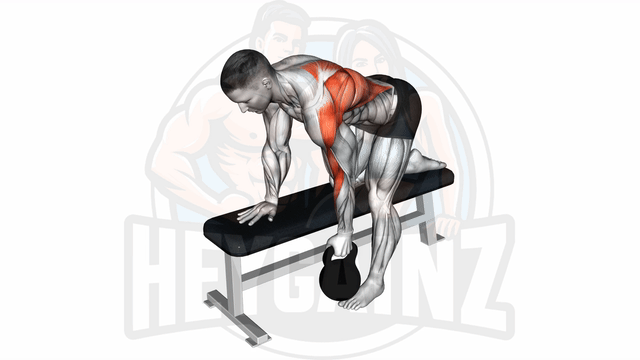
Instructions:
- 1Stand with your feet hip-width apart and a kettlebell on the ground between them.
- 2Bend at your hips and knees, grab the kettlebell with one hand.
- 3Pull the kettlebell up to your side, keeping your elbow tucked in.
- 4Hold for a moment, then lower the kettlebell back to the ground.
- 5Repeat the process with the other arm.
Tips:
- Keep your back straight during the exercise.
- Engage your core throughout the session. Don’t rely on your back alone, use all the muscles mentioned.
- Control the pacing, don't rush. Let your muscles feel the strain.
- Ensure your elbow is not flaring out to the side as you row
Kettlebell Bent-Over Row: A Comprehensive Guide
The kettlebell bent-over row is an effective exercise primarily targeting the back muscles, making it a favorite among fitness enthusiasts. Utilizing a kettlebell, this exercise not only enhances strength but also improves stability and posture. Also known as the KB bent-over row, this movement can be performed with various kettlebell variations, including the double kettlebell bent-over row and the alternating kettlebell bent-over row.
Muscles Worked
This exercise engages several key muscle groups. Primarily, the kettlebell bent-over row targets the latissimus dorsi (lats), rhomboids, and trapezius muscles in the back. Additionally, it helps develop the deltoids in the shoulders and works the biceps during the pulling phase. For a deeper understanding of the kettlebell bent over row muscles worked, consider how each of these muscle groups contributes to upper body strength and stability.
Benefits
The kettlebell bent over row benefits your overall fitness by improving back strength, promoting stability, and enhancing grip strength. Incorporating this exercise into your routine can also help prevent injuries by developing the muscles that support your spine and improve your functional movement patterns.
Exercise Tips and Cues
To maximize the benefits of the kettlebell bent-over row, pay attention to the following cues:
- Maintain a neutral spine: Ensure your back is straight throughout the movement to avoid strain.
- Engage your core: Keep your core tight to stabilize your body as you lift.
- Use controlled movements: Focus on pulling the kettlebell towards your torso in a controlled manner.
For those interested in variations, the kettlebell box bent-over row can provide additional stability, while the db kb bent-over row allows for flexibility in weight distribution. When performed correctly and consistently, the kettlebell bent-over row can be a cornerstone exercise in any strength training program.
For visual learners, a kettlebell bent over row gif can provide clarity on proper form and technique. As you incorporate this exercise into your workouts, remember to prioritize form and listen to your body to avoid injury and ensure maximum effectiveness.